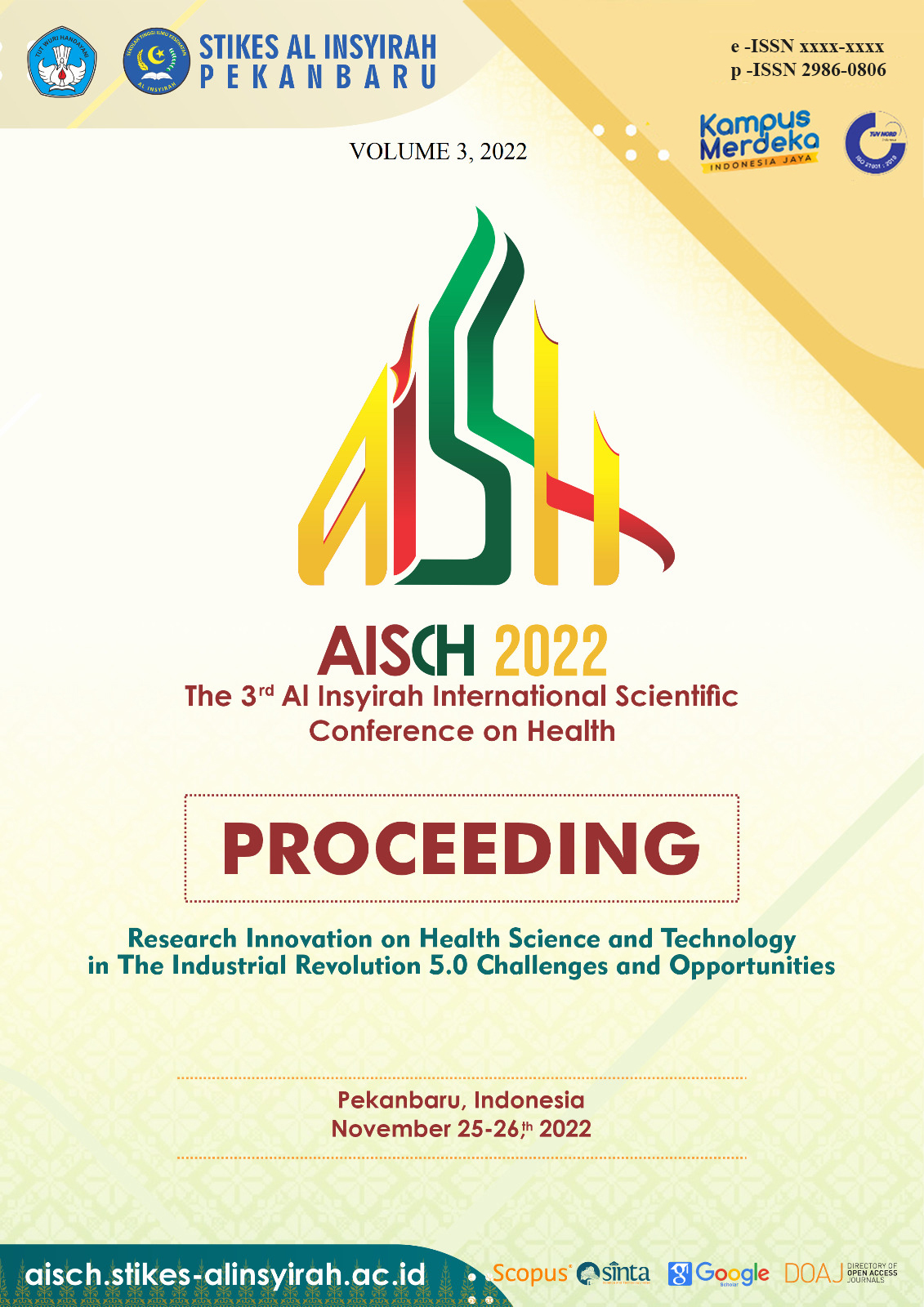FACTORS RELATED TO THE ACCURACY OF THE IMPLEMENTATION OF THE MODERN TRIAGE CANADIAN TRIAGE ACQUITY SYSTEM (CTAS)
Kata Kunci:
Factors, Accuracy, Triage, CTASAbstrak
Some patients who visit the Emergency Department (IGD) are not in an emergency condition, one way to sort it out is by triage. There are still many hospitals that are not appropriate in implementing triage, increasing the risk of death and disability of emergency patients. The purpose of this study was to determine the factors related to the accuracy of the implementation of modern triage CTAS. This research was conducted at the IGD of Bengkalis Regional Hospital. The total population is 20 emergency room nurses, with sampling using the total sampling technique. The analysis used is frequency distribution and chi square statistical test. The results of this study concluded that: Ada significant relationship between the level of knowledge of nurses and the accuracy of the implementation of the Modern Triage of the CTAS system (p value 0.002); Ada significant relationship between nurse skills and the accuracy of the implementation of the Modern Triage of the CTAS system (p value 0.011); Ada significant relationship between the perception of nurse workload and the accuracy of the implementation of the Modern Triage of the CTAS system (p value 0.00 0); Ada significant relationship between the length of work of the nurse and the accuracy of the implementation of the Modern Triage of the CTAS system (p value 0.003); A significant relationship between nurse training and the accuracy of the implementation of the Modern Triage CTAS system (p value 0.033). This study recommends improving the competence of all emergency room nurses, particularly through BTCLS training and modern triage of the CTAS system.
Unduhan
Referensi
Ahmil. (2018). Faktor-Faktor Yang Berhubungan Dengan Kepatuhan Perawat Dalam Pelaksanaan Standar Prosedur Operasional Triage Di Ruang Igd Rsud Undata Provinsi Sulawesi Tengah. Jurnal Kesmas, 7(6).
Ainiyah, N., Ahsan, & Fathoni, M. (2018). Analisis faktor pelaksanaan triage di Instalasi Gawat Darurat. Jurnal Ners, 10(1), 147–157.
Andersson, A. K., Omberg, M., & Svedlund, M. (2006). Triage in the emergency department – a qualitative study of the factors which nurses consider when making decisions. Nursing in Critical Care, 11(3), 136–145. https://doi.org/10.1111/j.1362-1017.2006.00162.x
Chen, S. S., Chen, J. C., Ng, C. J., Chen, P. L., Lee, P. H., & Chang, W. Y. (2010). Factors that influence the accuracy of triage nurses’ judgement in emergency departments. Emergency Medicine Journal, 27(6), 451–455. https://doi.org/10.1136/emj.2008.059311
Evie, S., Wihastuti, T. A., & Suharsono, T. (2016). Analisis Faktor Yang Berhubungan Dengan Pelaksanaan Triage Perawat Pelaksanadi Ruang Igd Rumah Sakit Tipe C Malang. Jurnal Ilmiah Kesehatan Keperawatan, 12(3), 144–153. https://doi.org/10.26753/jikk.v12i3.163
Gustia, Mila., Manurung, M. (2018). Hubungan ketepatan penilaian triase dengan tingkat keberhasilan penanganan pasien Cedera Kepala di IGD RSU HKBP Kabupaten Toba Samosir. Jurnal JUMANTIK, 3(2), 1–97.
Habib, H., Sulistio, S., Mulyana, R. M., & Albar, I. A. (2016). Triase Modern Rumah Sakit dan Aplikasinya di Indonesia. Research Gate, 3(2), 112–115. https://www.researchgate.net/profile/Hadiki_Habib/publication/311715654_Triase_Modern_Rumah_Sakit_dan_Aplikasinya_di_Indonesia/links/58576da608aeff086bfbd53d/Triase-Modern-Rumah-Sakit-dan-Aplikasinya-di-Indonesia.pdf
Khairina, I., Malini, H., & Huriani, E. (2018). Faktor-Faktor yang Berhubungan dengan Pengambilan Keputusan Perawat Dalam Ketepatan Triase Di Kota Padang. Indonesian Journal for Health Sciences, 2(1), 1. https://doi.org/10.24269/ijhs.v2i1.707
Lee, J. Y., Oh, S. H., Peck, E. H., Lee, J. M., Park, K. N., Kim, S. H., & Youn, C. S. (2011). The validity of the Canadian Triage and Acuity Scale in predicting resource utilization and the need for immediate life-saving interventions in elderly emergency department patients. Scandinavian Journal of Trauma, Resuscitation and Emergency Medicine, 19, 68. https://doi.org/10.1186/1757-7241-19-68
Lusiana, L. (2014). Faktor – Faktor Yang Mempengaruhi Perawat Dalam Pelaksanaan Triage Di Unit Gawat Darurat Rumah Sakit Puri Indah. 1–2.
Maatilu, V., Mulyadi, & Malara, R. T. (2014). Faktor-faktor yang berhubungan dengan respon time perawat pada penanganan pasien di igd rs manado. Program Studi Ilmu Keperawatan Fakultas Kedokteran Universitas Sam Ratulangi Manado, 2(2).
Musliha. (2010). Keperawatan Gawat Darurat Plus Contoh Askep dengan Pendekatan NANDA, NIC, NOC. Nuha Medika.
Nurhanifah. (2015). The relation of characteristics, workload and supervision with nurses motivation on implementing triage in emergency room banjarmasin ulin hospital 2015. 2(1), 75–87.
Puspitasari, I., & Masruroh, N. A. (2015). Evaluasi Medical Response Preparedness Pada Unit Gawat Darurat (Studi Kasus di IGD Rumah Sakit Umum Pusat Dr. Sardjito Yogyakarta). In Forum Teknik (Vol. 36).
Rumampuk, J., & Katuuk, M. E. (2019). Hubungan Ketepatan Triase Dengan Response Time Perawat Di Instalasi Gawat Darurat Rumah Sakit Tipe C. Jurnal Keperawatan, 7(1). https://doi.org/10.35790/jkp.v7i1.25206
Suhartati. (2011). Standar Pelayanan Keperawatan Gawat Darurat di Rumah Sakit. Kementerian Kesehatan RI.
Sunaryo. (2004). Psikologi Untuk Keperawatan. EGC.
Sutawijaya. (2009). Gawat Darurat. Aulia Publishing.
Yanty, G. (2014). ‘Hubungan tingkat pengetahuan dan sikap petugas kesehatan igd terhadap tindakan triage berdasarkan prioritas’, Skripsi, p. 2. Available at: http://jom.unri.ac.id/index.php/JOMPSIK/article/download/3530/3425. Ilmu Keperawatan, 2(1), 1–9.
Unduhan
Diterbitkan
Terbitan
Bagian
Lisensi
Hak Cipta (c) 2022 Al Insyirah International Scientific Conference on Health

Artikel ini berlisensi Creative Commons Attribution 4.0 International License.


